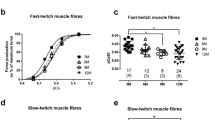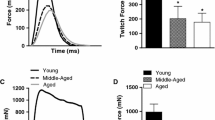Summary
Morphological and functional changes as well as changes in fibre-type composition were investigated in the left extensor digitorum longus (EDL) muscles of male Wistar rats of approximately 40, 60, 120 and 700 days old. A number of morphological changes occurred in the EDL muscle during growth. While from 40 to 120 days muscle mass and cross-sectional area (CSA) increased by 247 and 192%, changes in muscle and fibre lengths were much smaller (44 and 17%, respectively). Besides morphological changes tetanic force was also found to increase (approximately 307%) up to 120 days. Because this increase in force was greater than the increase in CSA, specific force increased by approximately 29% between 40 and 60 days. Thereafter, specific force stayed rather constant. From 40 until 60 days changes were also found in the force-frequency and force-velocity curve, which indicate a slowing of the muscles (until 60 days). Changes in fibre-type composition of the EDL muscle were found to occur later during growth between 60 and 120 days. In this period an increase in the relative total area of Type IIBd fibres and a decrease in the relative total area of Type IIBm fibres (corresponding to the Type 2X and IIB fibres, respectively), were found; this was apparently due to a conversion of many Type IIBm into Type IIBd fibres and not to a difference in cross-sectional growth between these fibres. Thus it seemed that the changes in the morphological parameters of rat EDL muscle occurred early in life, between 40 and 60 days of age, with a concomitant change in function but without changes in fibre-type composition, which occurred at later age.
Similar content being viewed by others
References
ASMUSSEN, A. & MARÉCHAL, G. (1989) Maximal shortening velocities, isomyosins and fibre types in soleus muscle of mice, rats and guinea pigs. J. Physiol. (Lond.) 416, 245–54.
AARANY, M. (1967) ATPase activity of myosin correlated with speed of muscle shortening. J. Gen. Physiol. 50, 197–216.
AARANY, M., AARANY, K., RECKARD, T. & VOLPE, A. (1965) Myosin of fast and slow muscles of the rabbit. Arch. Biochem. Biophys. 109, 185.
AOTTINELLI, R., SCHIAFFINO, S. & REGGIANI, C. (1991) Force-velocity relations and myosin heavy chain isoform compositions of skinned fibres from rat skeletal muscle. J. Physiol. (Lond.) 437, 655–72.
AROOKS, S. V. & FAULKNER, J. A. (1988) Contractile properties of skeletal muscles from young, adult and aged mice. J. Physiol. (Lond.) 404, 71–82.
AROOKE, M. H. & KAISER, K. K. (1970) Muscle fibre types: how many and what kind? Arch. Neurol. 23, 369–79.
CLOSE, R. (1964) Dynamic properties of fast and slow skeletal muscles of the rat during development. J. Physiol. (Lond.) 173, 74–95.
DeHAAN, A., JONES, D. A. & SARGEANT, A. J. (1989) Changes in velocity of shortening, power output and relaxation rate during fatigue of rat medial gastrocnemius muscle. Pflügers Arch. 413, 422–8.
EDDINGER, T. J., CASSENS, R. G. & MOSS, R. L. (1986) Mechanical and histochemical characterizations of skeletal muscles from senescent rats. Am. J. Physiol. 251 (Cell Physiol. 20), C421-C430.
FITTS, R. H., TROUP, J. P., WITZMANN, F. A. & HOLLOSZY, J. O. (1984) The effect of aging and exercise on skeletal muscle function. Mech. Ageing Dev. 27, 161–72.
GOLDSPINK, G. (1972) Postembryonic growth and differentiation of striated muscle. In The Structure and Function of Muscle (edited by AOURNE, G. H.) pp. 179–228. New York: Academic Press.
GOLLNICK, P. D., TIMSON, B. F., MOORE, R. L. & RIEDY, M. (1981) Muscular enlargement and number of fibres in skeletal muscles of rats. J. Appl. Physiol. 50, 936–43.
GUTH, L. & SAMAHA, F. J. (1970) Procedure for the histochemical demonstration of actomyosin ATPase. Exp. Neurol. 28, 365–7.
JONES, D. A., RUTHERFORD, O. M. & PARKER, D. F. (1989) Physiological changes in skeletal muscle as a result of strength training. Quart. J. Exp. Physiol. 74, 233–56.
LARSSON, L., ANSVED, T., EDSTRÖM, L., GORZA, L. & SCHIAFFINO, S. (1991) Effects of age on physiological, immunohistochemical and biochemical properties of fast-twitch single motor units in the rat. J. Physiol. (Lond.) 443, 257–75.
LIND, A. & KERNELL, D. (1991) Myofibrillar ATPase histochemistry of rat skeletal muscles: a ‘two-dimensional’ quantitative approach. J. Histochem. Cytochem. 39, 589–97.
LODDER, M. A. N., DeHAAN, A. & SARGEANT, A. J. (1991) Effect of shortening velocity on work output and energy cost during repeated contractions of the rat EDL muscle. Eur. J. Appl. Physiol. 62, 430–5.
MALTIN, C. A., DELDAY, M. I., AAILLIE, A. G. S., GRUBB, D. A. & GARLICK, P. J. (1989) Fiber-type composition of nine rat muscles I. Changes during the first year of life. Am. J. Physiol. 257 (Endocrin. Metab. 20), E823-E827.
MAXWELL, L. C., FAULKNER, J. A. & MURPHY, R. A. (1982) Relationship among fibre type, myosin ATPase activity and contractile properties. Histochem. J. 14, 981–97.
QUETELET, A. (1835) Sur l'Homme et le Développement de ses Facultés. Vol. 2. Paris: Bachelier, Imprimeur-Libraire.
SCHIAFFINO, S., SAGGIN, L., VIEL, A., AUSONI, S., SARTORE, S. & GORZA, L. (1986) Muscle fibre types identified by monoclonal antibodies to myosin heavy chains. In Biochemical Aspects of Physical Exercise (edited by AENZI, G., PACKER, L. & SILIPRANDI, N.) pp. 27–34. Amsterdam: Elsevier.
SCHIAFFINO, S., AUSONI, S., GORZA, L., SAGGIN, L., GUNDERSEN, K. & LØMO, T. (1988) Myosin heavy chain isoforms and velocity of shortening of type 2 skeletal muscle fibres. Acta Physiol. Scand. 134, 575–6.
SCHIAFFINO, S., GORZA, L., SARTORE, S., SAGGIN, L., AUSONI, S., VIANELLO, M., GUNDERSEN, K. & LØMO, T. (1989) Three myosin heavy chain isoforms in type 2 skeletal muscle fibres. J. Muscle Res. Cell Motil. 10, 197–205.
TAMAKI, N. (1985) Effect of growth on muscle capillarity and fibre type composition in rat diaphragm. Eur. J. Appl. Physiol. 54, 24–9.
WOITTIEZ, R. D., HEERKENS, Y. F., HUIJING, P. A., RIJNSBURGER, W. H. & ROZENDAL, R. H. (1986) Functional morphology of the M. gastrocnemius medialis of the rat during growth. J. Morph. 187, 247–58.
Author information
Authors and Affiliations
Rights and permissions
About this article
Cite this article
Lodder, M.A.N., De Haan, A., Lind, A. et al. Changes in morphological and functional characteristics of male rat EDL muscle during growth. J Muscle Res Cell Motil 14, 47–53 (1993). https://doi.org/10.1007/BF00132179
Received:
Revised:
Accepted:
Issue Date:
DOI: https://doi.org/10.1007/BF00132179




